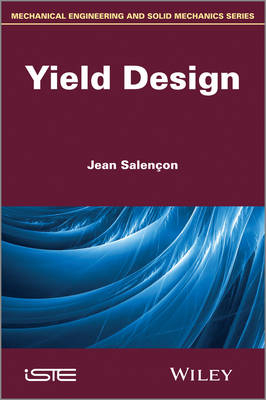
Yield Design
ISTE Ltd and John Wiley & Sons Inc (Verlag)
978-1-84821-540-5 (ISBN)
- Titel z.Zt. nicht lieferbar
- Versandkostenfrei innerhalb Deutschlands
- Auch auf Rechnung
- Verfügbarkeit in der Filiale vor Ort prüfen
- Artikel merken
Since the middle of the 20th Century yield design approaches have been identified with the lower and upper bound theorem of limit analysis theory – a theory associated with perfect plasticity. This theory is very restrictive regarding the applicability of yield design approaches, which have been used for centuries for the stability of civil engineering structures.
This book presents a theory of yield design within the original “equilibrium/resistance” framework rather than referring to the theories of plasticity or limit analysis; expressing the compatibility between the equilibrium of the considered structure and the resistance of its constituent material through simple mathematical arguments of duality and convex analysis results in a general formulation, which encompasses the many aspects of its implementation to various stability analysis problems.
After a historic outline and an introductory example, the general theory is developed for the three-dimensional continuum model in a versatile form based upon simple arguments from the mathematical theory of convexity. It is then straightforwardly transposed to the one-dimensional curvilinear continuum, for the yield design analysis of beams, and the two-dimensional continuum model of plates and thin slabs subjected to bending. Field and laboratory observations of the collapse of mechanical systems are presented along with the defining concept of the multi-parameter loading mode. The compatibility of equilibrium and resistance is first expressed in its primal form, on the basis of the equilibrium equations and the strength domain of the material defined by a convex strength criterion along with the dual approach in the field of potentially safe loads, as is the highlighting of the role implicitly played by the theory of yield design as the fundamental basis of the implementation of the ultimate limit state design (ULSD) philosophy with the explicit introduction of resistance parameters.
Contents
1. Origins and Topicality of a Concept.
2. An Introductory Example of the Yield Design Approach.
3. The Continuum Mechanics Framework.
4. Primal Approach of the Theory of Yield Design.
5. Dual Approach of the Theory of Yield Design.
6. Kinematic Exterior Approach.
7. Ultimate Limit State Design from the Theory of Yield Design.
8. Optimality and Probability Approaches of Yield Design.
9. Yield Design of Structures.
10. Yield Design of Plates: the Model.
11. Yield Design of Plates Subjected to Pure Bending.
About the Authors
Jean Salençon is Emeritus Professor at École polytechnique and École des ponts et chaussées, ParisTech, France. Since 2009 he has been a member of the Administrative Board of CNRS (Paris, France). He has received many awards including the Légion d’Honneur (Commander), Ordre National du Mérite (Officer) and Palmes Académiques (Commander). His research interests include structure analysis, soil mechanics and continuum mechanics.
Jean Salen?on is Emeritus Professor at ?cole polytechnique and ?cole des ponts et chaussées, ParisTech, France. Since 2009 he has been a member of the Administrative Board of CNRS (Paris, France). He has received many awards including the L?gion d-Honneur (Commander), Ordre National du M?rite (Officer) and Palmes Acad?miques (Commander). His research interests include structure analysis, soil mechanics and continuum mechanics.
Preface xi
Chapter 1. Origins and Topicality of a Concept 1
1.1. Historical milestones 1
1.2. Topicality of the yield design approach 8
1.3. Bibliography 11
Chapter 2. An Introductory Example of the Yield Design Approach 19
2.1. Setting the problem 19
2.2. Potential stability of the structure 22
2.3. To what extent potential stability is a relevant concept? 24
2.4. Bibliography 28
Chapter 3. The Continuum Mechanics Framework 29
3.1. Modeling the continuum 29
3.2. Dynamics 34
3.3. The theory of virtual work 41
3.4. Statically and kinematically admissible fields 46
3.5. Bibliography 48
Chapter 4. Primal Approach of the Theory of Yield Design 51
4.1. Settlement of the problem 51
4.2. Potentially safe loads 57
4.3. Comments 60
4.4. Some usual isotropic strength criteria 66
4.5. Bibliography 70
Chapter 5. Dual Approach of the Theory of Yield Design 73
5.1. A static exterior approach 73
5.2. A kinematic necessary condition 76
5.3. The π functions 78
5.4. π functions for usual isotropic strength criteria 84
5.5. Bibliography 88
Chapter 6. Kinematic Exterior Approach 91
6.1. Equation of the kinematic exterior approach 91
6.2. Relevant virtual velocity fields 94
6.3. One domain, two approaches 100
6.4. Bibliography 107
Chapter 7. Ultimate Limit State Design from the Theory of Yield Design 111
7.1. Basic principles of ultimate limit state design 111
7.2. Revisiting the yield design theory in the context of ULSD 113
7.3. The yield design theory applied to ULSD 114
7.4. Conclusion 117
7.5. Bibliography 118
Chapter 8. Optimality and Probability Approaches of Yield Design 119
8.1. Optimal dimensioning and probabilistic approach 119
8.2. Domain of potential stability 120
8.3. Optimal dimensioning 130
8.4. Probabilistic approach of yield design 133
8.5. Bibliography 141
Chapter 9. Yield Design of Structures 145
9.1. The curvilinear one-dimensional continuum 145
9.2. Implementation of the yield design theory 157
9.3. Typical strength criteria 164
9.4. Final comments 172
9.5. Bibliography 174
Chapter 10. Yield Design of Plates: the Model 177
10.1. Modeling plates as two-dimensional continua 177
10.2. Dynamics 182
10.3. Theorem/principle of virtual work 191
10.4. Plate model derived from the three-dimensional continuum 198
10.5. Bibliography 204
Chapter 11. Yield Design of Plates Subjected to Pure Bending 205
11.1. The yield design problem 205
11.2. Implementation of the yield design theory 208
11.3. Strength criteria and π functions 213
11.4. Final comments 226
11.5. Bibliography 234
Index 237
| Verlagsort | London |
|---|---|
| Sprache | englisch |
| Maße | 160 x 241 mm |
| Gewicht | 581 g |
| Themenwelt | Informatik ► Weitere Themen ► CAD-Programme |
| Technik ► Maschinenbau | |
| ISBN-10 | 1-84821-540-1 / 1848215401 |
| ISBN-13 | 978-1-84821-540-5 / 9781848215405 |
| Zustand | Neuware |
| Informationen gemäß Produktsicherheitsverordnung (GPSR) | |
| Haben Sie eine Frage zum Produkt? |
aus dem Bereich


